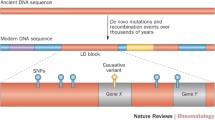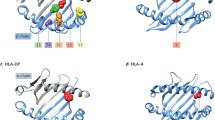Abstract
Recent progress in defining the role of genetic factors in rheumatoid arthritis (RA) has been remarkable. Anticyclic citrullinated peptide (anti-CCP) antibody-positive disease appears to be immunogenetically distinct from anti-CCP-negative disease, with the former subgroup primarily responsible for association and linkage with the HLA-DRB1 shared epitope (SE). There is preliminary evidence that non-HLA genes contribute differentially to anti-CCP-positive and negative disease. The phenotypic differences evident in anti-CCP-positive and negative disease suggest a need to reclassify RA based on the presence or absence of this autoantibody. Some recent work also suggests marked interactions between cigarette smoking, anti-CCP antibodies, and the SE, though these relationships may vary across populations. Lastly, a recent single nucleotide polymorphism-based genome-wide linkage analysis of multicase RA families revealed novel genomic regions that likely contain genes that predispose to RA or more specific phenotypes.
Similar content being viewed by others
References and Recommended Reading
MacGregor AJ, Sneider H, Rigby AS, et al.: Characterizing the quantitative genetic contribution to rheumatoid arthritis using data from twins. Arthritis Rheum 2000, 43:30–37.
Arnett FC, Edworthy SM, Bloch DA, et al.: The American Rheumatism Association 1987 revised criteria for the classification of rheumatoid arthritis. Arthritis Rheum 1998, 31:315–324.
Deighton CM, Criswell LA: The contribution of genetic factors to rheumatoid arthritis. In Rheumatology, 4th Edition. Edited by Hochberg MC, Silman AJ, Smolen JS, et al.: Edinburgh: Mosby; In press.
Gregersen PK, Silver J, Winchester R: The shared epitope hypothesis. An approach to understanding the molecular genetics of susceptibility to rheumatoid arthritis. Arthritis Rheum 1987, 30:1205–1213.
Newton JL, Harney SMJ, Wordsworth BP, Brown MA: A review of the MHC genetics of rheumatoid arthritis. Genes Immun 2004, 5:151–157.
Deighton CM, Walker DJ, Griffiths ID, Roberts DF: The contribution of HLA to rheumatoid arthritis. Clin Genet 1989, 36:178–182.
Deighton CM: What is the future for the genetics of rheumatoid arthritis? Brit J Rheumatol 1993, 32:857–858.
Schellekens GA, Visser H, de Jong BA, et al.: The diagnostic properties of rheumatoid arthritis antibodies recognizing a cyclic citrullinated peptide. Arthritis Rheum 2000, 45:155–163.
van GaalenFA, Linn-Rasker SP, van VenrooijWJ, et al.: Autoantibodies to cyclic citrullinated peptides predict progression to rheumatoid arthritis in patients with undifferentiated arthritis: a prospective cohort study. Arthritis Rheum 2004, 50:709–715.
Huizinga TW, Amos CI, van der Helm-van MilAH, et al.: Refining the complex rheumatoid arthritis phenotype based on specificity of the HLA-DRB1 shared epitope for antibodies to citrullinated proteins. Arthritis Rheum 2005, 52:3433–3438. A ground-breaking paper using association, linkage, an early RA cohort, and a large collection of affected sibling pairs to demonstrate significant genetic and phenotypic differences between anti-CCP positive and negative disease.
van der Helm-van MilAHM, Verpoort KN, Breedveld FC, et al.: The HLA-DRB1 shared epitope alleles are primarily a risk factor for anti-cyclic citrullinated peptide antibodies and are not an independent risk factor for development of rheumatoid arthritis. Arthritis Rheum 2006, 54:1117–1121. A useful paper in a large inception cohort that dissects out the interrelationships between anti-CCP, SE, and the progression of undifferentiated arthritis into RA.
Verpoort KN, van GaalenFA, van der Helm-van MilAHM, et al.: Associaition of HLA-DR3 with anti-cyclic citrullinated peptide antibody-negative rheumatoid arthritis. Arthritis Rheum 2005, 52:3058–3062.
Irigoyen P, Lee AT, Wener MH, et al.: Regulation of anticitrullinated peptide antibodies in rheumatoid arthritis: contrasting effects of HLA-DR3 and the shared epitope alleles. Arthritis Rheum 2005, 52:3813–3818.
van der Helm-van Mil AH, Huizinga TWJ, Schreuder GM, et al.: An independent role of protective HLA class II alleles in rheumatoid arthritis severity and susceptibility. Arthritis Rheum 2005, 2637–2644. A prospective study showing that DERAA sequences at the site of the shared epitope independently protect from RA, and render the disease less severe when present.
Gorman JD: Smoking and rheumatoid arthritis: another reason to just say no [editorial]. Arthritis Rheum 2006, 54:10–13.
Klareskog L, Stolt P, Lundberg K, et al.: A new model for an etiology of rheumatoid arthritis: smoking may trigger HLA-DR (shared epitope)-restricted immune reactions to autoantigens modified by citrullination. Arthritis Rheum 2006, 54:38–46. An important paper that demonstrates profound interactions between smoking, the SE, anti-CCP and the predisposition to RA. The paper also provides preliminary evidence for cigarette smoking leading to citrullination of alveolar proteins.
Padyukov L, Silva C, Stolt P, et al.: A gene-environment interaction between smoking and shared epitope genes in HLA-DR provides a high risk of seropositive rheumatoid arthritis. Arthritis Rheum 2004, 50:3085–3092.
Jawaheer D, Lum RF, Gregersen PK, Criswell LA: Influence of male sex on disease phenotype in familial rheumatoid arthritis. Arthritis Rheum 2006, In press.
Irigoyen P, Lee H-S, Vlietinck R, et al.: Lack of association between smoking and anti-CCP antibodies in three large North American cohorts [abstract]. Arthritis Rheum 2006, Submitted. Submitted abstract describing an important study based on a large sample of North American RA patients that contradicts the Swedish data.
Hill AJ, Southwood S, Sette A, et al.: Cutting edge: the conversion of citrulline to arginine allows for a high-affinity peptide interaction with the rheumatoid arthritis-associated HLA-DRB1*0401 MHC class II molecule. J Immunol 2003, 171:538–541.
Lundberg K, Nijenhuis S, Vossenaar E, et al.: Citrullinated proteins have increased immunogenicity and arthritogenicity and their presence in arthritic joints correlates with disease severity. Arthritis Res Ther 2005, 7:R458–467.
Hill J, Wehrli B, Jevnikar AM, et al.: Citrullinated.brinogen induces arthritis in HLA-DRB1*0401 transgenic mice [abstract]. Arthritis Rheum 2003, 48(Suppl 9):S348.
Masson-Bessiere C, Sebbag M, Girbal-Neuhauser E, et al.: The major synovial targets of the rheumatoid arthritisspeci fic antifilaggrin autoantibodies are deiminated forms of the alpha and beta-chains of fibrin. J Immunol 2001, 166:4177–4184.
Vossenaar ER, Despres N, Lapointe E, et al.: Rheumatoid arthritis specific anti-Sa antibodies target citrullinated vimentin. Arthritis Res Ther 2004, 6:R142–150.
Auger I, Sebbag M, Vincent C, et al.: Influence of HLA-DR genes on the production of rheumatoid arthritis-specific autoantibodies to citrullinated fibrinogen. Arthritis Rheum 2005, 52:3424–3432. An important study showing an association between HLADRB1* 0404 and the production of autoantibodies to citrullinated.brinogen, and to a lesser extent for other SEs.
Jawaheer D, Li W, Graham RR, et al.: Dissecting the genetic complexity of the association between human leukocyte antigens and rhuematoid arthritis. Am J Hum Genet 2002, 71:585–594.
Newton J, Brown MA, Milicic A, et al.: The effect of HLADR on susceptibility to rheumatoid arthritis is influenced by the associated lymphotoxin alpha-tumor necrosis factor haplotype. Arthritis Rheum 2003, 48:90–96.
Kilding R, Iles MM, Timms JM, et al.: Additional genetic susceptibility for rheumatoid arthritis telomeric of the DRB1 locus. Arthritis Rheum 2004, 50:763–769.
Brintnell W, Eleftheria Z, Barton A, et al.: Evidence for a novel rheumatoid arthritis susceptibility locus on chromosome 6p. Arthritis Rheum 2004, 50:3823–3830.
Laivoranta-Nyman S, Mottonen T, Hermann R, et al.: HLADR-DQ haplotypes and genotypes in Finnish patients with rheumatoid arthritis. Ann Rheum Dis 2004, 63:1406–1412.
Khanna D, Wu H, Park G, et al.: Association of tumor necrosis factor alpha polymorphism, but not the shared epitope, with increased radiographic progression in a seropositive rheumatoid arthritis inception cohort. Arthritis Rheum 2006, 54:1105–1116.
Oliver JE, Worthington J, Silman AJ: Genetic epidemiology of rheumatoid arthritis. Curr Op Rheumatol 2006, 18:141–146. A useful update of non-MHC contributions to RA, influences on disease severity and treatment response. Covers areas that the current review could not due to space restrictions.
Amos CI, Chen WV, Lee A, et al.: High-density SNP analysis of 642 Caucasian families with rheumatoid arthritis identifies two new linkage regions on 11p12 and 2q33. Genes Immun 2006, Epub ahead of print. The largest single linkage analysis performed to date, demonstrating linkage with new loci not previously described. Also demonstrating further genetic differences between anti-CCP positive and negative disease.
Wordsworth P, Bell J: Polygenic susceptibility in rheumatoid arthritis. Ann Rheum Dis 1991, 50:343–346.
John S, Amos C, Shephard N, et al.: Linkage analysis of rheumatoid arthritis families in US and UK families reveals interactions between HLA-DRB1 and loci on chromosomes 6q and 16p. Arthritis Rheum 2006, 54:1482–1490. A collaboration between two U.S. studies and one U.K. family study using joint modeling with HLA and demonstrating significant linkage for susceptibility genes on 6q and 16p.
Fisher SA, Lanchbury JS, Lewis CM: Meta-analysis of four rheumatoid arthritis genome-wide linkage studies. Confirmation of a susceptibility locus on chromosome 16. Arthritis Rheum 2003, 48:1200–1206.
Gregersen PK, Batliwalla F: PTPN22 and rheumatoid arthritis: gratifying replication [editorial]. Arthritis Rheum 2005, 1952–1955. A useful overview of the latest research on PTPN22 and RA. A Canadian study providing the latest support for this locus influencing RA appears in the same journal.
Hinks A, Worthington J, Thomson W: The association of PTPN22 with rheumatoid arthritis and juvenile idiopathic arthritis [editorial]. Rheumatology 2006, 45:365–368. A useful overview of the latest research on PTPN22 and RA.
Begovich AB, Carlton VE, Honigberg LA, et al.: A misssense single-nucleotide polymorphism in a gene encoding a protein tyrosine phosphatase (PTPN22) is associated with rheumatoid arthritis. Am J Hum Genet 2004, 75:330–337.
Burkhardt H, Hüffmeier U, Spiewald B, et al.: HLADRB1 shared epitope and humoral autoimmunity to an immunodominant epitope of cartilage-specific type II collagen in early rheumatoid arthritis. Arthritis Rheum 2006, 54:82–89. An interesting observation of anticartilage antibodies in a minority of early RA patients, but showing associations with the SE and PTNP22.
Plenge RM, Padyokov L, Remmers EF, et al.: Replication of putative candidate-gene associations with rheumatoid arthritis in >4,000 samples from North America and Sweden: Association of susceptibility with PTPN22, CTLA4, and PAD14. Am J Hum Genet 2005, 77:1044 -1060. A population sufficiently powered to address non-HLA genes in RA and showing further differences in genetic associations with anti-CCP positive RA.
Author information
Authors and Affiliations
Corresponding author
Rights and permissions
About this article
Cite this article
Deighton, C., Criswell, L.A. Recent advances in the genetics of rheumatoid arthritis. Curr Rheumatol Rep 8, 394–400 (2006). https://doi.org/10.1007/s11926-006-0071-x
Issue Date:
DOI: https://doi.org/10.1007/s11926-006-0071-x




